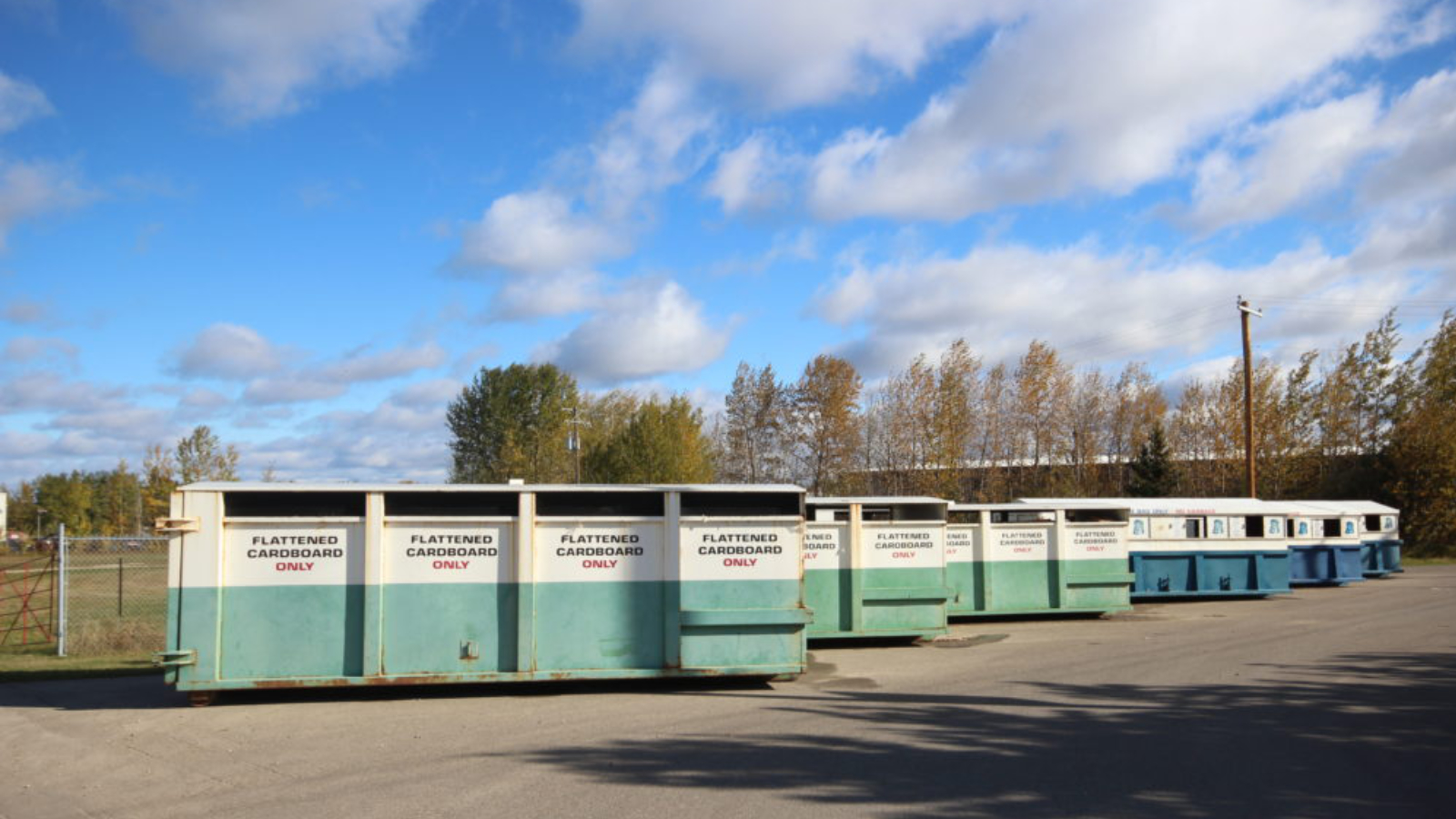Drayton Valley’s recycling depot is on the move. The depot will be relocated to an area close to the landfill later this year.
The recycling depot has been located on Industrial Road for several years. The new location is designed to provide a more convenient drop off point for residents who are also taking loads to the landfill or the Take it or Leave it Centre while dropping off materials for recycling. It’s also hoped that the move will minimize illegal dumping of non-recyclables which has been a problem at the current location.
“Moving the recycling depot provides an all encompassing site for waste management and recycling in Drayton Valley and will hopefully curb the illegal dumping taking place at the current location and will be safer for our residents,” says Owen Olynyk, who is the Town’s General Manager of Infrastructure.
An all Canadian team that included a local resident was able to win the rodeo for the first time in the history of the World Famous Miles City Bucking Horse Cowboy Mardi Gras.
Wilfred Titanich was one of a team of three that attended the three-day event in Miles City, Montana from May 15-18. Titanich along with two brothers, Cory and Cody Loken, were the first all Canadian team to win at Bucking Horse since the first Miles City Bucking Horse Sale started in 1951.
Each member of the team came home with around $7,500 US, says Titanich.
“We got Championship Buckles and we got Championship Holders, too,” he says.
The team participated in the Wild Horse Racing event, which involves at least three people and an untouched horse. The horse starts out in the bucking chute and two members of the team follow the horse out, holding onto a long lead. One person is the mugger, and their job is to control the horse’s head by covering its eyes with his arm, which calms it and prevents it from rearing and hurting someone. The shanker holds onto the rope so it doesn’t run away. The rider saddles it, mounts, and holds on tight as they race to the finish line on a wild horse.
“Wild Horse Racing is one of the oldest events in rodeo,” says Titanich.
Though the event is called Wild Horse Racing, the horses used in the event are owned, but untouched.
Throughout the year, Titanich works the Canadian Wild Horse Racing Association Circuit, spending most of his time in Alberta, but also attending some events in B.C. and Saskatchewan, where he competes in both amateur and pro rodeos.
“Honestly, it’s really addicting,” says Titanich. “It looks really crazy, and it is pretty wild, but it’s super addicting. It’s an adrenaline rush in sport.”
He says he would encourage people who like competitive events to try Wild Horse Racing.
The Loken brothers have both been in the sport for about 15 years, says Titanich. Both of them were about 14-years-old when they first started out. Titanich has been in the sport for three or four years.
Normally, the Lokens race with their dad, Jason, and Titanich has his own team. But the three of them thought it would be fun to head down to Miles City for some fun.
The Bucking Horse Sale was a stand-alone event, says Titanich. His team is getting ready for the circuit this summer.
“We can rodeo every weekend from now to the end of October,” he says.
Anyone looking for information about which wild horse racing rodeos are coming up can visit www.wildhorseracing.ca. Titanich says he will be in Brooks at the Lea Park Rodeo this weekend and in Killam for the Killam Rodeo that will be held outdoors in Sedgewick this year.
From Oklahoma to Keystone: Uncovering Hidden Histories at the Breton Library
An author who has written a non-fiction book that ties the Breton area to a mysterious child in Oklahoma will be visiting the Breton Library on June 7.
Russell Cobb, author of Ghosts of Crook County: An Oil Fortune, A Phantom Child, and the Fight for Indigenous Land is a Professor of Modern Languages and Cultural Studies at the University of Alberta. He was invited to the library by the Breton Library Board and the Breton Museum.
Allan Goddard, the manager of the Breton Museum, says he met Cobb when the author was working on the manuscript for the novel.
“He came out to the museum because there is a connection to the Hooks family,” he says.
Goddard says while the book does have some history about the Keystone area, and some relatives that may still live in the area, it is mainly about what indigenous families had to deal with in the early 1900s in Oklahoma.
Claire Sather, the Chair of the Board of Trustees for the Breton Library, says she read the book after finding it on Goodreads, a social media site dedicated to book ratings and reviews.
She says when she got to the end and saw a familiar name, Brandy Fredrickson, it really registered how close some events in the book are tied to the area.
Goddard says when Jim Crow laws came into being in Oklahoma, it triggered an exodus of African Americans from Oklahoma to seek out refuge in Canada. A group of those immigrants settled around Breton in the Keystone area in the early 1900s.
The book centres around a child named Tommy Atkins, whose existence has never truly been proven, and the oilmen who were snatching up indigenous lands in Oklahoma. Goddard says one of the women rumoured to be Atkins’ mother lived in Keystone for a while before returning to Oklahoma.
Both Sather and Goddard are excited to have him visit the Library, however, the space is limited. Those who wish to attend the event on Saturday, June 7th at 1 p.m. have to pre-register to ensure they get a spot.
Those who are interested can register by calling the library at 780-696-3740 or send an email to bretonlibrary@yrl.ab.ca.
Cobb has also written The Great Oklahoma Swindle: Race, Religions, and Lies in America’s Weirdest State.
VE Day at 80: How World War II Is Fading from Living Memory
Eighty years ago this week a group of men gathered in a room in Berlin to sign a piece of paper which brought an end to six years of war in Europe.
It was one of the most significant turning points of the last 1,000 years. It’s an event which will be remembered as well as any in the history of humanity. But history is very much what it is becoming.
World War II will never be forgotten, but it is rapidly becoming little more than a memory.
Anyone involved in the actual fighting would be, at the very least, in their mid-90s. Today the median age in Canada is somewhere around 40. That means the war belongs more to our grandparents’ generation than to our parents’. We’re now approaching the point where no one alive will remember World War II .
Sad as that may seem, it’s part of the inevitable ebb and flow of human events. Things move on. No one today mourns the 65,000 who died at the Battle of Waterloo or those who lost their lives at a thousand other places from Thermopylae to Gettysburg. Instead we are more likely to dress up as them and re enact the events of the day, for reasons that, I must confess, have never been entirely clear to me.
And so it will be with World War II. Certainly the events 25 years earlier at Ypres, the Somme and Passchendaele have now taken on a sepia tinge. They have gone from being a horrendous bloodbath to a historical curiosity.
Time moves on. It’s a natural process and not something we could reverse even if we wanted to.
Years ago I worked with a copy editor who would indignantly write “which one?” in the margins of any news story that simply referred to “the war.” At the time I thought he was a bit of a dickhead. But now, well, I’m still pretty sure he was a dickhead, but he may have been a dickhead with a point.
The world has been far from peaceful since May of 1945. For one thing, the war in Asia was still raging on this day in 1945 and would not end for a few more months with the fall of Japan. But, also this week in 1954 the French were defeated by the Vietnamese in the battle of Dien Bein Phu. This week in 1960 the Soviet Union announced it was holding American U2 pilot Gary Powers. This week in 1999 NATO accidentally bombed the Chinese Embassy in Kosovo. And if you checked the news this morning you probably saw that war continues in Ukraine. Tragedy is continuing to unfold in Gaza. And, well, you get the picture.
Still, by asking “which war” my former colleague may have been a little bit ahead of his time. When someone mentions “The War”most of us will immediately think of 1939-1945.
But time will prove my copy editor’s point. Events, even the most important events in the world, gradually fade into history.
It won’t happen overnight, but make no mistake, it will happen. The process is already under way.
Drayton Valley looks at rural wealth creation
In partnership with the University of Alberta’s Community University Partnership (CUP) town council will be looking at different ways that Drayton Valley residents can work to generate local wealth for the community.
Geraldine Cahill, the director of UpSocial Canada who works with CUP, along with Dr. Maria Mayan from the U of A, spoke to council about initiatives that other municipalities have taken on to help stimulate local economies.
CUP has been working in Drayton Valley since 2020, when they helped the Town develop the Zero Fee Tuition Program, now called the Tuition Assistance Bursary. The partnership was developed for a research project to explore whether the ZFT program could be a mechanism for an inclusive economy.
“The results so far have been very positive, both on employment and also for quality of life for participants,” said Cahill.
Cahill told council they had engaged with stakeholders during the research and found a strategy that they would like to explore with the Town. They believe that Rural Wealth Creation could be an effective initiative to help Drayton Valley navigate increased costs in a way that can benefit the entire community.
“Across the country there has been a pattern of downloading costs and responsibilities to municipalities… without much change in capital transfers,” said Cahill. “That puts a great deal of strain on municipal governments and single-resource towns have been hard hit by this.”
With RWC, the Town would work together with residents to develop ways that residents can invest in community projects as part of their retirement, thus ensuring a larger chunk of local money stays in the municipality.
Over the past few years communities across the country have achieved economic stability by using programs such as co-operatives, local procurement, employee ownership and other succession models, community bonds, community land trusts and more. Cahill also provided examples from some of the municipalities that have gone in this direction.
In 2002, the municipality of Westlock learned that their grain terminals were going to be sold. As agriculture was one of the important sectors for the community, there was concern about how the sale could affect the local economy. So, instead of letting the grain terminals go, the community worked together to raise $1.2 million to purchase the grain terminal.
Those who invested in the terminal now get yearly dividends for their investment. They also have the most profitable terminal for its size in Canada and are planning on diversifying into a transport company.
Cahill says that the size of the municipality may play a role in which type of community program would work best.
Mayor Nancy Dodds asked Cahill how the Town could move forward with the plan as they would have to play a role in whatever path residents choose to move forward with.
“As the Town, as leaders, we want to be involved, but we don’t want to be getting in the way,” said Dodds. “How do you make sure that everyone has their say when you’re picking that.”
CUP has a workshop planned for May 5 at Clean Energy Technology Centre to help brainstorm some ideas that may work in the community. Cahill says everyone is welcome to attend and they will be looking at community assets as well as asking attendees what their priorities are.
Cahill says once they get some feedback from the meeting, she can use those priorities and ideas to generate profiles of which programs could best address them and how it would affect the community.
“Then we can shop them around for several months,” says Cahill. “I don’t want to rush the process so that people have a chance to weigh in.”
60 years strong: St. Anthony School plans celebration and future growth
In January 1965, the St. Anthony School opened its doors. Now, 60 years later, the school is planning a celebration of the milestone.
Principal Janelle Molzan says they are planning to have a celebration on May 24 at the school gym. They will be using the event to also fundraise for the school.
Molzan says they will have a band performing that evening, catering from a local restaurant, a full cash bar, as well as some door prizes.
Part of the celebration will also be the fact that St. Thomas Aquinas Roman Catholic School Division has put St. Anthony at the top of their priority list for a new school. Molzan says the division has to wait until next year to submit their request to the Province, and there is no guarantee that they will be selected for funding.
“It could be anywhere from two to ten years,” she says. “Or more.”
However, she feels that St. Anthony has a strong case for asking for a new school.
The most recent remodel of the school was in 1992, says Molzan. At that point they expanded the school, removing the gym from the centre of the school and installing classrooms instead. The new gym was then built as an addition to the school.
“We had the addition of the gym as well as a few classrooms in 1992,” says Molzan.
Since then, there have been no major remodels or renovations. Instead, the staff have been doing what they can to keep the building in shape.
“It’s a really well built school,” says Molzan.
She says over the years, the natural heaves and settling that occur with temperature fluctuations has led to some cosmetic damages to the building. “It’s just showing its age,” she says.
While the school is starting to show wear, Molzan says there are no capacity issues. About 15 years ago, the school went from being a K-12 school to a K-8 school when the Holy Trinity Academy was built.
Molzan says if they don’t get a new school they will have to pursue getting more renovations or remodeling for the current building.
New trespassing program helps businesses
Businesses will now have another option for dealing with trespassers thanks to a new program that Enforcement Services have put into place.
Cody Rossing, the manager of enforcement services and emergency management for the Town, says one of the biggest challenges for businesses in the community who were issuing trespass notices is that someone has to attend court in order for the trespassing charge to stick. With the new Trespassing Agent program which comes into place on March 20, businesses who enrol will not have to attend court.
Previously, businesses who contacted the RCMP to report a trespasser had to issue the trespass notices themselves.
For many businesses the process didn’t work well. Larger franchises, like banks, found arranging the issue of a trespass notice and attending court was not logistically feasible. Small business owners, on the other hand, could issue the notice but may have to close their business in order to attend court.
Rossing says there are two different pieces of legislation that speak to trespassing, the Petty Trespass Act and the Trespass to Premises Act.
“Under both of the legislations, the property owner or their agent are required to provide trespass notices, help get people off of their land, and stuff like that,” says Rossing.
The first offence fine under the provincial legislation is normally $600, but it could be up to $10,000. A second offence could have a fine of up to $25,000
The higher fines come into place when the individual ignores the notice and returns to the property. If the trespasser returns three times, the officers can then issue a summons to court. If they fail to attend, a warrant is issued, and at that point if they are found guilty, the higher fines can be given.
Rossing says the program is helping streamline the process for businesses. If they choose to enrol in the program, it will allow peace officers or the RCMP to act as their agent and issue the notices. It also means the business owners won’t have to attend court.
“Court is scary for a lot of people, and we understand that,” says Rossing.
The purpose of the program is to improve the process because officers are continuing to get calls to the same place over and over and business owners or their employees are uncomfortable with the court process. Until now, there hasn’t been any way to address those issues.
“It’s been a lot of work on the back end because there is no follow up process in place and there is no trespass notice being issued,” says Rossing.
He says the hope is that by having this program in place, businesses can sign up and they can begin to address the issue more efficiently.
Several different municipalities in the province have a similar program in place, says Rossing. While developing the program, Rossing did research on other initiatives and reached out to other municipalities that had something similar in place. He says he wanted to be sure that he had everything in place before he announced the program in the community.
There are also checks and balances that have been worked into the program.
“If you’re trespassed from a local business, one of our officers shows up and says you’re trespassed for six months, if you don’t agree with it, you can appeal that process,” says Rossing.
He says there is also the option for the business owners to speak with the officer and reduce the amount of time the individual is trespassed for. In some cases, if the RCMP issue a notice that’s in effect for six months, a business owner may come forward and advocate for the trespasser if the individual doesn’t normally behave in that manner
“They can say, ‘This person is normally a good customer, but there is something going on with him right now. I think maybe a month would be more appropriate,’” says Rossing.
However, it is ultimately the final discretion of the officer.
Once a business is enrolled in the program, they will receive a sticker that they can place in a conspicuous area that is easily visible for officers. If they receive a call, the officer will know that they can issue the notice themselves rather than speaking to the owner and explaining the process that has to take place.
Rossing says enrolment in the program is free, and he encourages businesses to sign up if they are having consistent issues with people loitering or being a nuisance on their property. Those who are interested in enrolling can visit www.draytonvalley.ca/enforcementservices/trespassingagent and fill out the form. They can then email it in to enforcement@draytonvalley.ca or drop it off at the Town office.
The change in location will also mean a small cost saving to the Town.
The new location will be at the main entrance to the landfill and will be fenced off from the rest of the site to allow for 24-hour access. Recycling can be dropped off at no charge and residents will not have to cross the landfill scales to drop off recyclables. The remainder of the landfill will continue to operate as normal.
One local youth has seen his hard work with 4-H pay off after being selected as one of 12 youth to show their steers at the 2025 Calgary Stampede Junior Steer Classic.
Hunter Harris is a third generation 4-H member and has been part of the organization since he was 12 years old. Not only does he show cattle for 4-H, he’s also been entering open shows for the past two years. He says showing cattle is just a natural extension of his life as the son and grandson of farmers.
“I think it’s really important to know where your food comes from and I really enjoy showing,” says Harris. He says he also feels like he’s staying true to his heritage working in agriculture, which he is something he is proud of and wants to continue doing.
As an ambassador, Harris got his choice of steer from the OH Ranch this month. At the next Calgary Stampede, he will bring that steer back to show in the Calgary Stampede Junior Steer Classic under a special category for OH Beef.
He says being chosen as an ambassador is an honour and he’s excited to use the opportunity to help educate people about the importance of the industry.
“I think it means putting myself out there and trying to put out a positive image for both the Calgary Stampede and the beef industry as a whole,” says Harris. “As an ambassador, I feel I have the responsibility to try and promote the show world, the beef industry, and this way of life as much as I can.”
Beef showing a competitive sport
He says there is a lot of work that goes into showing and that he considers it a competitive sport, no different than horse showing or dog showing. Each year, Harris works with the steer or heifer he’s chosen. He’s responsible for feeding it, grooming it, and training it, which means spending time with it nearly every day for more than half a year.
“You’ve got to put in a ton of time. You have to be able to halter break it and get it tame,” says Harris. “There’s a process of training it to stand a certain way, how to respond to certain cues when you’re pulling on their halter, and how they should lead and behave in the show ring.”
It’s also important to put time into research about the proper feed for the steer. Harris says the type of food they are fed will greatly impact the standing in competition as well as the sale of the steer for butcher. He says there is a certain balance between fat and muscle that needs to be kept to make good meat.
At the show, all of the cattle get a fitting from the competitors to make sure they look their best when in the ring.
“It’s kind of like hairstyling, but for cows, in a sense,” he says.
Fitting involves cleaning the cow, blow drying them, clipping them, brushing tufts and styling them in certain ways to make the cow look its best in the show.
“It kind of brings out the best traits in them so they look like a better market animal,” he says.
Harris says he plans to attend more open shows this year and hopefully have the opportunity to help educate people about the industry. In the past, he’s spoken with young spectators at events who come up to see his cow and shared a little bit about the importance of the event.
“I just wanted to make sure they were enjoying themselves and that they learned something,” says Harris. “The ladies that were showing [the children] around were learning stuff, too. I think it’s really important to try and connect with everyone on all levels and tell them what an amazing sport it is and how important it is.”
He says that sometimes it can be sad to see the cow go after working with it for so long. But Harris says it’s important for him to remember why he is doing it in the first place, and that families will be fed well because of his efforts.
While Harris is still contemplating what the future could hold for himself in terms of a career, he’s pretty certain that he will likely end up working with cattle and in the agriculture industry. He’s already been working on building up his own herd with his time and money, and a little bit of help from his family. He feels that this will give him a headstart in life and also makes a good choice as an ambassador.
“My parents have been extremely supportive of it, and they’ve helped me out a ton,” he says.
Harris believes his experience in working with his herd makes him more knowledgeable about the industry. He’s been learning about the traditions and the work that goes into maintaining a herd, including breeding, feeding, and the general well-being of the animals.
“I think that makes me a better showman and in a better position to be an ambassador,” he says.
Those who wish to know how Harris’ steer holds up to the other 11 ambassadors will have to wait until the July 2025 Calgary Stampede or hope to catch him at one of the several shows he plans to attend.
Tomahawk to receive a $1 million dollar upgrade
For the first time ever, the Tomahawk School volleyball team was able to host a home game thanks to their new gym.
Tracey Gilmour, the new principal for the school, says the new gym was a $1 million project. It was started last May and was finally finished on October 16, hours before their opening game.
“They were bringing the scissor lift out as we brought in the net,” says Gilmour.
The Timberwolves went on to win their first home game against the Muir Lake Mustangs.
“They were a little bit worried that actually performing at home would put some pressure on them,” says Gilmour. “But they did great.”
“I was very nervous and excited at the same time,” says Layla Chausse, one of the Timberwolves.
Team practice was a challenge in the past
While the school has always had team sports, Gilmour says it’s been a challenge for the teams to practice, and they’ve never been able to host a game before. The size of the gym wasn’t necessarily the problem. The issue was a large stage that took up about a third of the space in the room.
Gilmour says the stage made it difficult for the students to play any type of sports in the gym. She says small games could work, but a full sized game wasn’t possible.
The previous principal, Fran Bell, really advocated for the students saying they should have equal opportunities to access sports and extracurriculars.
“Parkland School Division stepped up and made that investment in our school,” says Gilmour.
After years of playing away games, the team was happy to finally get to play on their home turf.
“It was really nice to play in the gym for the first time,” says Josie Woodruff, one of the players. “We’re especially grateful to be able to play a home game.” She says their team has never had the opportunity to play in a new gym before.
The fact that they were the very first people to use the gym was something the team enjoyed, as well.
Strocher says winning is just icing on the cake
“We were really excited to have our first home game and be the first ones to play in that gym,” says Isabelle Strocher. She says winning that first game was just icing on the cake.
Up until the home opener, the girls had been practicing outside on a paved area near the school. Gilmour says it hasn’t been easy for the team, but they persevered, and had won every single game going into the home opener.
“Honestly, I think what got them through was their amazing team spirit,” says Gilmour. “I’ve never seen anything like it. They’re so supportive of each other.”
That team spirit has helped the Timberwolves make it into the playoffs this year.
“We’ve finished our placement games,” says Judith Munch. “Now we just have playoffs, and we’re hoping to host one, too.”
Members of business community voice concerns over local issues
Some local businesses gathered last week to voice concerns, propose possible solutions, and brainstorm a presentation to put before town council.
Erik Bergen, one of the owners of the Drayton Valley Bakery, held a meeting on October 9 and invited all businesses in the community to come out. Bergen wanted to hear their thoughts on three specific topics: homelessness, essential service administration and the Town’s free enterprise policy.
Bergen says the idea about having a presentation has been on his mind for several months. He says he’s spoken to many business owners who feel frustrated with the Town and the direction council is taking. However, he says he felt that if everybody only talked about it and no one went to the town, nothing would get accomplished.
Along with business owners, the organizers of Warming Hearts and members of the public attended the event.
Homelessness and franchises stir debate
Bergen prepared a presentation for the event, and reviewed it several times as people came and went as they were able. He also had a petition available for attendees to sign.
As he went over his presentation, Bergen says it was difficult to focus on the problems and solutions rather than opinions.
“It did derail a little bit, just because of the opposite points of view, especially regarding the homeless,” he says.
There were some attendees who viewed the homeless issue from a more humanitarian point of view and others that felt a heavier hand was needed. But Bergen says it’s important to
remember that not all homeless people are causing the issue. There are some individuals who are making it difficult for everyone.
“I don’t want to group all people into one basket,” says Bergen. “There are people who are homeless because their house burned down or were dealt a bad hand.”
Another topic that brought up differing opinions was new franchises coming into the community. In his presentation, Bergen argued that by simply leaving the door open for any new businesses in the community, council was putting a strain on businesses that were already established.
According to Bergen, there is about one restaurant (or registered kitchen) for every 95 people in the community. There are more than eight liquor stores and six cannabis stores, 12 pizza places and more than one of some franchises.
He believes that a lack of direction from council in this matter is making it difficult for businesses to do well. Bergen says his concern is protecting the current businesses that the town already has in place and allow them to flourish.
“A lot of these restaurant owners say that they’re one franchise away from closing their doors,” says Bergen.
Town services and the need for improvement
Bergen says that many people have also noticed a disparity in the services the Town offers the community. For example, there are a number of different “nice” things the Town has spent money on like the pumptrack, disc golf, the pool etc. However, there are some struggles with providing basic services such as regular road maintenance, weed control and pest management.
“Maybe they are doing the best they can do, or maybe they got pushed to the back burner,” says Bergen.
He says that he got a lot of feedback from those who attended the meeting. As it was his first time attempting anything like this, there was a learning curve and Bergen says he’s looking forward to making improvements at another meeting that will be held at the beginning of November.
Bergen’s plan is to present a list of complaints with possible solutions to council in November.
The Town is making some changes to its Facility Code of Conduct in an effort to ensure its facilities aren’t being misused.
Cody Rossing, the manager of enforcement and emergency management, presented council with a proposed amendment to the Code of Conduct. Rossing says the Code of Conduct was put in place in August 2016. Since council expressed concern surrounding enforcement of removing homeless individuals from the Civic Centre vestibule, administration reviewed the code and came up with some suggestions.
Rossing says there are several different prohibitions that were not included in the original Code of Conduct. Most of the changes were stronger wording surrounding loitering and failing to comply with signage. While the original code prohibited smoking, it did not mention vaping, so Rossing says they have changed that.
The wording surrounding service animals was also changed to match provincial law.
The proposed changes also give more power to facility managers when it comes to banning individuals from Town facilities. They will be able to ban individuals for up to seven days. General managers and peace officers will also be able to suspend someone for up to six months. CAOs will be able to ban someone for more than six months if necessary.
“It’s putting in those different layers so the CAO isn’t involved in everything,” says Rossing.
He says there are also changes to wording surrounding the appeals process of someone who has been banned for more than 24 hours.
“And it clarifies that if someone is contravening their suspension or expulsion, then they are considered trespassing and law enforcement will be made aware for further actions,” says Rossing.
Councillor Colin Clarke raised concerns about the bans, asking if a ban from Town facilities meant all Town-owned buildings, even if there were tennants operating out of some of them. He says he worried that banning someone from the Omniplex might affect their ability to go to the Food Bank or other necessary services.
Hans van Klaveren, the acting CAO, says that typically the operator is setting those guidelines or rules for their building.
Councillor Tom McGee also spoke about the Warming Hearts Centre as the Town helps to fund the rent for the facility through grants.
In the end, it was decided that if a tenant wanted to have someone trespassed, they would contact Rossing and it would be treated like other businesses in the community. Their bans will only apply to Town owned and operated facilities.
“I’m glad to see we’re addressing this and putting the structure in place to give you the tools to do something about it,” says Councillor Rick Evans.
“I think that, in the end, our residents are going to appreciate our efforts to make the use of our facilities more enjoyable and safe, ultimately.”
Download your experience guide
Spending a weekend cycling the secondary highway in and around Brazeau County is one of the great outdoor activities that this region has to offer. Minutes outside of Drayton Valley you will find yourself on kilometers of highway that seem to continue to stretch West. Many of these highways go near small hamlets and communities in the area, they go into and come out of river valleys and on a clear day offer a beautiful view of the Rocky Mountains.
One such circuit is the DV100 century loop. This 100km route takes you west past farmlands and through lush boreal forests, and through the small communities and hamlets that mark the birth of Alberta’s oil and gas industry. It is a loop that can be done with speed or taken at a leisurely pace, offering snack and eatery stops along the way.

Day 1: Arrival, dinner
Arrive at hotel: When you stay at a Drayton Valley Hospitality and Tourism hotel or campground you support local tourism initiatives in Drayton Valley and Brazeau County.
Evening ride: Stretch your legs and do the 19 km ring road multipurpose trails to Rocky Rapids. Park your vehicle at the “Welcome to Drayton Valley” derricks at the south end of town and right across the street you will be on the trails. The route will take you straight out to the hamlet of Rocky Rapids where you can stop off at the Rocky Rapids store for a snack. The original building is located at the Drayton Valley museum.
Dinner: Did you know we have over 40 different restaurants in Drayton Valley? Look at our restaurant listing in this guide.
Ricochet Aquatic Centre: Take in the steamroom and the hot tub at the local swimming pool. The pool is open until 8:00 pm most nights and will get you ready for your big century ride tomorrow.
Day 2: The DIY DV100
Breakfast: Take in some breakfast at your hotel or head out to one of our great breakfast venues.
DIY DV100: The DV100 is a 100 kilometre route that travels secondary highways in Brazeau County. Along the route there are several spots you can stop to regroup, take in a photo and enjoy some food. Just out of town is the Poplar Ridge Store, this is your last stop to get any supplies until you reach the community of Lodgepole about about kilometre 40.
Arrive Lodgepole: this is a small hamlet that has a general store in the heart of town. Here you can grab a drink, and convenience store fare. There is also the hotel restaurant that is open 11-12:30 and 3-8 most days, there is also the Aud Spot for breakfast and lunch as a cash only option.
Heading out of Lodgepole towards Cynthia there are a few great photo opportunities as you crest a hill coming up from the Pembina River Valley. This is a slog of a climb but once you crest it is smooth sailing to Cynthia.
Near the Hamlet of Cynthia there is the ever popular Cyn City Saloon where you can get a beverage and a burger. Heading back towards Drayton Valley and Hwy 621 your next stop is 39 km away in the community of Rocky Rapids where you can stop at the store for some snacks and then back into town.
(In the Evening)
Hotel: regroup at your hotel and get ready for the evening.
Dinner: Drayton Valley has more than 40 different restaurants. Have a look at our listings page to decide where you want to eat.
Drinks: Head to a patio and enjoy the sunset with an ice cold brew. Lounge patios can be found at; Khal’s Steakhouse, Boston Pizza, Mitch’s Restaurant, Oil Country Tap House, Bourbon House and Mr. Mikes.

Day 3 Check out, walk and head home
Breakfast: Breakfast at your hotel or check out and head to a local restaurant for brunch.
Disc golf or a walk: If you want to stretch your time here in Drayton Valley, head over to Ivan To Park for a walk around the pond or a round of disc golf. The park has an 18-hole disc golf course that is open at no charge. If you’re pushed for time there’s an easy cut off to limit your round to 9 holes.
Head home. We hope you’ve enjoyed your time in our community. Come back soon!
Staff Sergeant Ryan Hoetmer says dealing with the effects of the homeless population in the community is not simple.
Hoetmer says that the most common complaint regarding homeless individuals is about them sleeping or spending time in business entrances. That was one of the main issues raised by town council in a discussion on September 18.
Hoetmer says RCMP involvement in removing the individual and charging them with trespassing is a bit tricky, especially in regards to private businesses.
“The police themselves do not make a determination of whether that homeless individual can be there or not,” says Hoetmer. “That has to be the business that decides that.”
This means that someone from the business has to contact the RCMP to let them know there is an unwanted individual in the vestibule. At that point, police can attend and get the individual moving along.
However, unless the business has served trespass notices on the person causing the issue, the RCMP cannot issue fines for trespassing.
That is also not as simple as it seems. Hoetmer says that does give the trespass notice has to be willing to pursue the entire process into court as well.
“They’ve got to show up at trial if this individual fights it,” he says.
Hoetmer says banks, for example, are not typically interested in pursuing this as they all have nationally run security headquarters, so there’s not a lot of interest in them following those steps.
Both the Town and RCMP have met with bank managers and are encouraging them to lock their doors at night to prevent the homeless from using the vestibule as a warming space.
Due to the lifestyle that comes with homelessness, which often includes mental health issues and addictions, the RCMP do interact with the homeless on a regular basis.
“We get to know these individuals, but unless they are commiting crime we don’t have a lot of power,” he says.
He says the Town has asked them to have more enforcement on homeless individuals who have been banned or issued trespassing notices.
“Our job is community safety so if that’s what the community wants to keep the community safe, we’ve agreed to do that,” says Hoetmer.
However, that means businesses need to start following through with the process on their end.
In regards to the Civic Centre vestibule, Hoetmer says the Town would need to start looking at trespassing individuals in order for the RCMP to begin issuing tickets.
“That is up to the Town whether they want to trespass these individuals from all Town property,” says Hoetmer.
But even with all of the businesses doing their part and the RCMP able to keep up with the enforcement, there is still more to consider.
“Enforcement has failed these individuals for years. Nobody usually becomes unsheltered without probably having had enforcement intervention for a number of years already, and it hasn’t changed anything.”
Hoetmer says there have been no complaints of physical harm caused to residents by any homeless individuals. “They can be aggressive and make people feel uncomfortable, but we have had no assaults. No reports of any sort of physical violence to anybody.”
In regards to break and enters, Hoetmer says some of the smaller property crimes are being committed by homeless individuals, but they aren’t the only ones.
“There’s other individuals in town that are not homeless that are committing those offences,” says Hoetmer. “The bigger break and enters are being committed by prolific property crime offenders.”
In regards to issuing fines for trespassing, Hoetmer says that also isn’t as simple as many believe. Those who have fines may not be able to pay them. At some point, they can be arrested, but there is no guaranteed timeline for how long the individual will stay behind bars, as they will be released first if room is needed for people convicted of more serious crimes.
In the end, the fines do not get paid.
Hoetmer says he doesn’t want the Town to “hang their hat on enforcement,” because while it can play a role in deterring homeless individuals from becoming a nuisance, it’s not the entire solution.
“We’re going to have a role,” says Hoetmer. “Our job is keeping the community safe. So, if part of that is needing to enforce, then we will do that.”
While no firm date for the move has been set, it’s expected to happen some time this autumn.
One local youth has seen his hard work with 4-H pay off after being selected as one of 12 youth to show their steers at the 2025 Calgary Stampede Junior Steer Classic.
Hunter Harris is a third generation 4-H member and has been part of the organization since he was 12 years old. Not only does he show cattle for 4-H, he’s also been entering open shows for the past two years. He says showing cattle is just a natural extension of his life as the son and grandson of farmers.
“I think it’s really important to know where your food comes from and I really enjoy showing,” says Harris. He says he also feels like he’s staying true to his heritage working in agriculture, which he is something he is proud of and wants to continue doing.
As an ambassador, Harris got his choice of steer from the OH Ranch this month. At the next Calgary Stampede, he will bring that steer back to show in the Calgary Stampede Junior Steer Classic under a special category for OH Beef.
He says being chosen as an ambassador is an honour and he’s excited to use the opportunity to help educate people about the importance of the industry.
“I think it means putting myself out there and trying to put out a positive image for both the Calgary Stampede and the beef industry as a whole,” says Harris. “As an ambassador, I feel I have the responsibility to try and promote the show world, the beef industry, and this way of life as much as I can.”
Beef showing a competitive sport
He says there is a lot of work that goes into showing and that he considers it a competitive sport, no different than horse showing or dog showing. Each year, Harris works with the steer or heifer he’s chosen. He’s responsible for feeding it, grooming it, and training it, which means spending time with it nearly every day for more than half a year.
“You’ve got to put in a ton of time. You have to be able to halter break it and get it tame,” says Harris. “There’s a process of training it to stand a certain way, how to respond to certain cues when you’re pulling on their halter, and how they should lead and behave in the show ring.”
It’s also important to put time into research about the proper feed for the steer. Harris says the type of food they are fed will greatly impact the standing in competition as well as the sale of the steer for butcher. He says there is a certain balance between fat and muscle that needs to be kept to make good meat.
At the show, all of the cattle get a fitting from the competitors to make sure they look their best when in the ring.
“It’s kind of like hairstyling, but for cows, in a sense,” he says.
Fitting involves cleaning the cow, blow drying them, clipping them, brushing tufts and styling them in certain ways to make the cow look its best in the show.
“It kind of brings out the best traits in them so they look like a better market animal,” he says.
Harris says he plans to attend more open shows this year and hopefully have the opportunity to help educate people about the industry. In the past, he’s spoken with young spectators at events who come up to see his cow and shared a little bit about the importance of the event.
“I just wanted to make sure they were enjoying themselves and that they learned something,” says Harris. “The ladies that were showing [the children] around were learning stuff, too. I think it’s really important to try and connect with everyone on all levels and tell them what an amazing sport it is and how important it is.”
He says that sometimes it can be sad to see the cow go after working with it for so long. But Harris says it’s important for him to remember why he is doing it in the first place, and that families will be fed well because of his efforts.
While Harris is still contemplating what the future could hold for himself in terms of a career, he’s pretty certain that he will likely end up working with cattle and in the agriculture industry. He’s already been working on building up his own herd with his time and money, and a little bit of help from his family. He feels that this will give him a headstart in life and also makes a good choice as an ambassador.
“My parents have been extremely supportive of it, and they’ve helped me out a ton,” he says.
Harris believes his experience in working with his herd makes him more knowledgeable about the industry. He’s been learning about the traditions and the work that goes into maintaining a herd, including breeding, feeding, and the general well-being of the animals.
“I think that makes me a better showman and in a better position to be an ambassador,” he says.
Those who wish to know how Harris’ steer holds up to the other 11 ambassadors will have to wait until the July 2025 Calgary Stampede or hope to catch him at one of the several shows he plans to attend.
Tomahawk to receive a $1 million dollar upgrade
For the first time ever, the Tomahawk School volleyball team was able to host a home game thanks to their new gym.
Tracey Gilmour, the new principal for the school, says the new gym was a $1 million project. It was started last May and was finally finished on October 16, hours before their opening game.
“They were bringing the scissor lift out as we brought in the net,” says Gilmour.
The Timberwolves went on to win their first home game against the Muir Lake Mustangs.
“They were a little bit worried that actually performing at home would put some pressure on them,” says Gilmour. “But they did great.”
“I was very nervous and excited at the same time,” says Layla Chausse, one of the Timberwolves.
Team practice was a challenge in the past
While the school has always had team sports, Gilmour says it’s been a challenge for the teams to practice, and they’ve never been able to host a game before. The size of the gym wasn’t necessarily the problem. The issue was a large stage that took up about a third of the space in the room.
Gilmour says the stage made it difficult for the students to play any type of sports in the gym. She says small games could work, but a full sized game wasn’t possible.
The previous principal, Fran Bell, really advocated for the students saying they should have equal opportunities to access sports and extracurriculars.
“Parkland School Division stepped up and made that investment in our school,” says Gilmour.
After years of playing away games, the team was happy to finally get to play on their home turf.
“It was really nice to play in the gym for the first time,” says Josie Woodruff, one of the players. “We’re especially grateful to be able to play a home game.” She says their team has never had the opportunity to play in a new gym before.
The fact that they were the very first people to use the gym was something the team enjoyed, as well.
Strocher says winning is just icing on the cake
“We were really excited to have our first home game and be the first ones to play in that gym,” says Isabelle Strocher. She says winning that first game was just icing on the cake.
Up until the home opener, the girls had been practicing outside on a paved area near the school. Gilmour says it hasn’t been easy for the team, but they persevered, and had won every single game going into the home opener.
“Honestly, I think what got them through was their amazing team spirit,” says Gilmour. “I’ve never seen anything like it. They’re so supportive of each other.”
That team spirit has helped the Timberwolves make it into the playoffs this year.
“We’ve finished our placement games,” says Judith Munch. “Now we just have playoffs, and we’re hoping to host one, too.”
Members of business community voice concerns over local issues
Some local businesses gathered last week to voice concerns, propose possible solutions, and brainstorm a presentation to put before town council.
Erik Bergen, one of the owners of the Drayton Valley Bakery, held a meeting on October 9 and invited all businesses in the community to come out. Bergen wanted to hear their thoughts on three specific topics: homelessness, essential service administration and the Town’s free enterprise policy.
Bergen says the idea about having a presentation has been on his mind for several months. He says he’s spoken to many business owners who feel frustrated with the Town and the direction council is taking. However, he says he felt that if everybody only talked about it and no one went to the town, nothing would get accomplished.
Along with business owners, the organizers of Warming Hearts and members of the public attended the event.
Homelessness and franchises stir debate
Bergen prepared a presentation for the event, and reviewed it several times as people came and went as they were able. He also had a petition available for attendees to sign.
As he went over his presentation, Bergen says it was difficult to focus on the problems and solutions rather than opinions.
“It did derail a little bit, just because of the opposite points of view, especially regarding the homeless,” he says.
There were some attendees who viewed the homeless issue from a more humanitarian point of view and others that felt a heavier hand was needed. But Bergen says it’s important to
remember that not all homeless people are causing the issue. There are some individuals who are making it difficult for everyone.
“I don’t want to group all people into one basket,” says Bergen. “There are people who are homeless because their house burned down or were dealt a bad hand.”
Another topic that brought up differing opinions was new franchises coming into the community. In his presentation, Bergen argued that by simply leaving the door open for any new businesses in the community, council was putting a strain on businesses that were already established.
According to Bergen, there is about one restaurant (or registered kitchen) for every 95 people in the community. There are more than eight liquor stores and six cannabis stores, 12 pizza places and more than one of some franchises.
He believes that a lack of direction from council in this matter is making it difficult for businesses to do well. Bergen says his concern is protecting the current businesses that the town already has in place and allow them to flourish.
“A lot of these restaurant owners say that they’re one franchise away from closing their doors,” says Bergen.
Town services and the need for improvement
Bergen says that many people have also noticed a disparity in the services the Town offers the community. For example, there are a number of different “nice” things the Town has spent money on like the pumptrack, disc golf, the pool etc. However, there are some struggles with providing basic services such as regular road maintenance, weed control and pest management.
“Maybe they are doing the best they can do, or maybe they got pushed to the back burner,” says Bergen.
He says that he got a lot of feedback from those who attended the meeting. As it was his first time attempting anything like this, there was a learning curve and Bergen says he’s looking forward to making improvements at another meeting that will be held at the beginning of November.
Bergen’s plan is to present a list of complaints with possible solutions to council in November.
The Town is making some changes to its Facility Code of Conduct in an effort to ensure its facilities aren’t being misused.
Cody Rossing, the manager of enforcement and emergency management, presented council with a proposed amendment to the Code of Conduct. Rossing says the Code of Conduct was put in place in August 2016. Since council expressed concern surrounding enforcement of removing homeless individuals from the Civic Centre vestibule, administration reviewed the code and came up with some suggestions.
Rossing says there are several different prohibitions that were not included in the original Code of Conduct. Most of the changes were stronger wording surrounding loitering and failing to comply with signage. While the original code prohibited smoking, it did not mention vaping, so Rossing says they have changed that.
The wording surrounding service animals was also changed to match provincial law.
The proposed changes also give more power to facility managers when it comes to banning individuals from Town facilities. They will be able to ban individuals for up to seven days. General managers and peace officers will also be able to suspend someone for up to six months. CAOs will be able to ban someone for more than six months if necessary.
“It’s putting in those different layers so the CAO isn’t involved in everything,” says Rossing.
He says there are also changes to wording surrounding the appeals process of someone who has been banned for more than 24 hours.
“And it clarifies that if someone is contravening their suspension or expulsion, then they are considered trespassing and law enforcement will be made aware for further actions,” says Rossing.
Councillor Colin Clarke raised concerns about the bans, asking if a ban from Town facilities meant all Town-owned buildings, even if there were tennants operating out of some of them. He says he worried that banning someone from the Omniplex might affect their ability to go to the Food Bank or other necessary services.
Hans van Klaveren, the acting CAO, says that typically the operator is setting those guidelines or rules for their building.
Councillor Tom McGee also spoke about the Warming Hearts Centre as the Town helps to fund the rent for the facility through grants.
In the end, it was decided that if a tenant wanted to have someone trespassed, they would contact Rossing and it would be treated like other businesses in the community. Their bans will only apply to Town owned and operated facilities.
“I’m glad to see we’re addressing this and putting the structure in place to give you the tools to do something about it,” says Councillor Rick Evans.
“I think that, in the end, our residents are going to appreciate our efforts to make the use of our facilities more enjoyable and safe, ultimately.”
Download your experience guide
Spending a weekend cycling the secondary highway in and around Brazeau County is one of the great outdoor activities that this region has to offer. Minutes outside of Drayton Valley you will find yourself on kilometers of highway that seem to continue to stretch West. Many of these highways go near small hamlets and communities in the area, they go into and come out of river valleys and on a clear day offer a beautiful view of the Rocky Mountains.
One such circuit is the DV100 century loop. This 100km route takes you west past farmlands and through lush boreal forests, and through the small communities and hamlets that mark the birth of Alberta’s oil and gas industry. It is a loop that can be done with speed or taken at a leisurely pace, offering snack and eatery stops along the way.

Day 1: Arrival, dinner
Arrive at hotel: When you stay at a Drayton Valley Hospitality and Tourism hotel or campground you support local tourism initiatives in Drayton Valley and Brazeau County.
Evening ride: Stretch your legs and do the 19 km ring road multipurpose trails to Rocky Rapids. Park your vehicle at the “Welcome to Drayton Valley” derricks at the south end of town and right across the street you will be on the trails. The route will take you straight out to the hamlet of Rocky Rapids where you can stop off at the Rocky Rapids store for a snack. The original building is located at the Drayton Valley museum.
Dinner: Did you know we have over 40 different restaurants in Drayton Valley? Look at our restaurant listing in this guide.
Ricochet Aquatic Centre: Take in the steamroom and the hot tub at the local swimming pool. The pool is open until 8:00 pm most nights and will get you ready for your big century ride tomorrow.
Day 2: The DIY DV100
Breakfast: Take in some breakfast at your hotel or head out to one of our great breakfast venues.
DIY DV100: The DV100 is a 100 kilometre route that travels secondary highways in Brazeau County. Along the route there are several spots you can stop to regroup, take in a photo and enjoy some food. Just out of town is the Poplar Ridge Store, this is your last stop to get any supplies until you reach the community of Lodgepole about about kilometre 40.
Arrive Lodgepole: this is a small hamlet that has a general store in the heart of town. Here you can grab a drink, and convenience store fare. There is also the hotel restaurant that is open 11-12:30 and 3-8 most days, there is also the Aud Spot for breakfast and lunch as a cash only option.
Heading out of Lodgepole towards Cynthia there are a few great photo opportunities as you crest a hill coming up from the Pembina River Valley. This is a slog of a climb but once you crest it is smooth sailing to Cynthia.
Near the Hamlet of Cynthia there is the ever popular Cyn City Saloon where you can get a beverage and a burger. Heading back towards Drayton Valley and Hwy 621 your next stop is 39 km away in the community of Rocky Rapids where you can stop at the store for some snacks and then back into town.
(In the Evening)
Hotel: regroup at your hotel and get ready for the evening.
Dinner: Drayton Valley has more than 40 different restaurants. Have a look at our listings page to decide where you want to eat.
Drinks: Head to a patio and enjoy the sunset with an ice cold brew. Lounge patios can be found at; Khal’s Steakhouse, Boston Pizza, Mitch’s Restaurant, Oil Country Tap House, Bourbon House and Mr. Mikes.

Day 3 Check out, walk and head home
Breakfast: Breakfast at your hotel or check out and head to a local restaurant for brunch.
Disc golf or a walk: If you want to stretch your time here in Drayton Valley, head over to Ivan To Park for a walk around the pond or a round of disc golf. The park has an 18-hole disc golf course that is open at no charge. If you’re pushed for time there’s an easy cut off to limit your round to 9 holes.
Head home. We hope you’ve enjoyed your time in our community. Come back soon!
Staff Sergeant Ryan Hoetmer says dealing with the effects of the homeless population in the community is not simple.
Hoetmer says that the most common complaint regarding homeless individuals is about them sleeping or spending time in business entrances. That was one of the main issues raised by town council in a discussion on September 18.
Hoetmer says RCMP involvement in removing the individual and charging them with trespassing is a bit tricky, especially in regards to private businesses.
“The police themselves do not make a determination of whether that homeless individual can be there or not,” says Hoetmer. “That has to be the business that decides that.”
This means that someone from the business has to contact the RCMP to let them know there is an unwanted individual in the vestibule. At that point, police can attend and get the individual moving along.
However, unless the business has served trespass notices on the person causing the issue, the RCMP cannot issue fines for trespassing.
That is also not as simple as it seems. Hoetmer says that does give the trespass notice has to be willing to pursue the entire process into court as well.
“They’ve got to show up at trial if this individual fights it,” he says.
Hoetmer says banks, for example, are not typically interested in pursuing this as they all have nationally run security headquarters, so there’s not a lot of interest in them following those steps.
Both the Town and RCMP have met with bank managers and are encouraging them to lock their doors at night to prevent the homeless from using the vestibule as a warming space.
Due to the lifestyle that comes with homelessness, which often includes mental health issues and addictions, the RCMP do interact with the homeless on a regular basis.
“We get to know these individuals, but unless they are commiting crime we don’t have a lot of power,” he says.
He says the Town has asked them to have more enforcement on homeless individuals who have been banned or issued trespassing notices.
“Our job is community safety so if that’s what the community wants to keep the community safe, we’ve agreed to do that,” says Hoetmer.
However, that means businesses need to start following through with the process on their end.
In regards to the Civic Centre vestibule, Hoetmer says the Town would need to start looking at trespassing individuals in order for the RCMP to begin issuing tickets.
“That is up to the Town whether they want to trespass these individuals from all Town property,” says Hoetmer.
But even with all of the businesses doing their part and the RCMP able to keep up with the enforcement, there is still more to consider.
“Enforcement has failed these individuals for years. Nobody usually becomes unsheltered without probably having had enforcement intervention for a number of years already, and it hasn’t changed anything.”
Hoetmer says there have been no complaints of physical harm caused to residents by any homeless individuals. “They can be aggressive and make people feel uncomfortable, but we have had no assaults. No reports of any sort of physical violence to anybody.”
In regards to break and enters, Hoetmer says some of the smaller property crimes are being committed by homeless individuals, but they aren’t the only ones.
“There’s other individuals in town that are not homeless that are committing those offences,” says Hoetmer. “The bigger break and enters are being committed by prolific property crime offenders.”
In regards to issuing fines for trespassing, Hoetmer says that also isn’t as simple as many believe. Those who have fines may not be able to pay them. At some point, they can be arrested, but there is no guaranteed timeline for how long the individual will stay behind bars, as they will be released first if room is needed for people convicted of more serious crimes.
In the end, the fines do not get paid.
Hoetmer says he doesn’t want the Town to “hang their hat on enforcement,” because while it can play a role in deterring homeless individuals from becoming a nuisance, it’s not the entire solution.
“We’re going to have a role,” says Hoetmer. “Our job is keeping the community safe. So, if part of that is needing to enforce, then we will do that.”
Drayton Valley Ski Hill Closes After 60 Years | Challenges with Weather, Insurance, and Volunteers
After 60 years of operation in the community, the Drayton Valley ski hill has closed its doors.
Randy Beckett, the president of the Drayton Valley Brazeau Snow Club, says there were three main factors that went into the decision to shut down: weather, insurance, and lack of volunteers.

Drayton Valley Food Bank relies on generosity
Explore the growing demand for the Drayton Valley Food Bank as it tackles record-breaking hamper distribution, facility challenges, and rising standards. Learn how community generosity keeps the vital service thriving in Alberta despite obstacles.”

Drayton Valley Launches Platform to Match Volunteers with Opportunities
Discover how Drayton Valley’s new online platform, This Is Drayton Valley (TIDV), connects volunteers with local organizations. Simplify finding meaningful opportunities to share your skills and make a difference in the community.

Man charged after shooting near Brazeau Dam
An Edmonton man has been charged with attempted murder after an incident that took place near the Brazeau Dam last week.
























